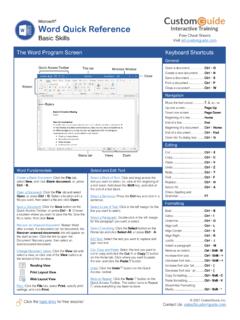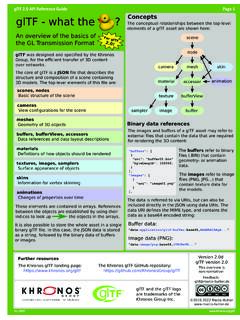Transcription of Medicare Ground Ambulance Data Collection System (GADCS) …
1 Medicare Ground Ambulance Data Collection System (GADCS). Required Information for Collection and Reporting quick reference Guide Updated March 8, 2022. I. Overview and Resources This document provides a brief overview of the GADCS and lists the specific information that sampled Ground Ambulance organizations must collect and report through the GADCS. The Medicare Ground Ambulance Data Collection Instrument is the set of questions that sampled Ground Ambulance organizations will answer when they report information to the GADCS. The Instrument contains questions relating to your organization's characteristics, service area, emergency response time (if applicable), mix of Ground Ambulance services ( , basic life support versus advanced life support and emergency versus non-emergency transports), costs (including those related to labor, facilities, vehicle, equipment, consumables, supplies, and other), and revenues ( , payments from health insurers) and provides instructions on how to report this information.
2 A printable version of the Medicare Ground Ambulance Data Collection Instrument is available on CMS' Ambulances Services Center website at Part III of this document walks through the type of information covered by the instrument. Please see the printable instrument for details on specific questions. The Ambulances Services Center website lists other resources, including prior presentations and a Frequently Asked Questions (FAQ) document ( for-Service-Payment/AmbulanceFeeSchedule /Downloads/ Medicare - Ground - Ambulance - ), that may be helpful to Ground Ambulance organizations preparing to collect and report information to the GADCS. Please email if you have questions regarding this document or the GADCS.
3 II. Timeline and Process Overview CMS developed the GADCS to meet the requirements described in paragraph (17) of section 1834 (l) of the Social Security Act. CMS is required by law to collect information on costs, revenue, utilization and other information from representative samples of Ground Ambulance organizations. This information will be analyzed by the Medicare Payment Advisory Commission (MedPAC), a government body independent from CMS, to develop a report to Congress on the adequacy of Medicare payment rates for Ground Ambulance services and geographic variations in the cost of furnishing such services. 1. The figure above provides a high-level overview of the timeline for the data Collection and data reporting requirements under the GADCS.
4 In brief, CMS first selects and notifies participants in each of four representative samples of Ground Ambulance organizations (Step 1). Selected organizations have 30 days following receipt of notification to submit important initial information, including contact information and the start of the organization's data Collection period, to CMS (Step 2). After reporting this initial information, organizations will collect data over a continuous 12- month data Collection period (Step 3). Organizations can choose to use a calendar year as their reporting period or, if different than a calendar year, their fiscal year. Two types of users, data submitters and certifiers, will need to create accounts and link to the sampled NPI via a web-based GADCS portal currently under development by CMS (Step 4).
5 Submitters are responsible for entering information into the web-based instrument ( , questions organized by section). Certifiers will review complete responses and certify the information is complete and accurate before submitting the response to CMS. Organizations must report and certify their response before the end of their data reporting period, a 5-month period starting immediately after the end of the organization's data Collection period (Step 5). CMS will notify organizations that do not sufficiently report information and may apply a 10 percent payment reduction on Medicare Part B Ambulance Fee Schedule services during the next calendar year to organizations that do not sufficiently report (Step 6).
6 Ultimately, MedPAC will analyze the data reported to CMS to determine the adequacy of Medicare payments for Ground Ambulance services and geographic variations in the cost of furnishing such services. MedPAC will submit a report including its recommendations to Congress. III. Required Information for Collection and Reporting The bullet lists below summarizes the information in the Medicare Ground Ambulance Data Collection Instrument across its 13 sections. Ground Ambulance organizations selected to participate in the GADCS must collect and report all information below that is applicable to their organization. The grey boxes below list information applicable only to certain types of Ground Ambulance organizations based on organizational characteristics and the services that are provided.
7 Unless otherwise specified, all questions ask for information collected over your organization's continuous, 12-month data Collection period. 2. A. Organizational Characteristics and Service Area (Instrument Sections 2 & 3). How you categorize your Ground Ambulance organization among several organization types. Whether your organization provides services other than Ground Ambulance services. Whether your organization operates land and/or water ambulances. Whether your organization provides certain types and levels of services ( , responses to emergency calls for service). Your organization's overall staffing model. Whether your organization uses any volunteer labor. The ZIP codes which you consider to comprise your service area.
8 B. Services Volume and Mix (Instrument Sections 4, 5, & 6). Your organization's approximate average trip time (in minutes). Number of total responses for all calls for service. Number of total Ground Ambulance responses involving a fully equipped and staffed Ground Ambulance , regardless of whether the response resulted in a transport. Whether your Ground Ambulance organization responds to calls with another non- transporting agency (such as a local fire department) that is not part of your organization, and the types of staff involved. Your organization's number of Ground Ambulance responses that did not result in a transport and, of these, the share where the patient received medical treatment on site.
9 Your organization's number of Ground Ambulance responses that did result in a transport. Your organization's number of Ground Ambulance transports during the data Collection period that were paid in part or in full by any health insurer or patient by the time you report data. Whether your organization participates in standby events (paid or unpaid). The number of paramedic intercepts for which your organization provided an Advanced Life Support (ALS) level of service for which another organization provides an Ambulance transport. Excluding paramedic intercepts meeting Medicare 's definition, the number of responses for which your organization provided ALS intervention as a joint response to meet a Basic Life Support (BLS) Ambulance from another organization.
10 The share of Ground Ambulance transports by level of service by billing code. The share of Ground Ambulance services that were interfacility. Box 1: Services Provided Information Applicable to Certain Organization Types Organizations that use more than one NPI to bill Medicare : Your parent organization's number of Ground Ambulance transports, including the number of transports across all Ground Ambulance organizations and NPIs owned or operated by the parent organization. Organizations Responding to Emergency Calls for Service: How your organization currently tracks response times. 3. Average response time. The share of emergency responses with response times more than twice your organization's average response time.















